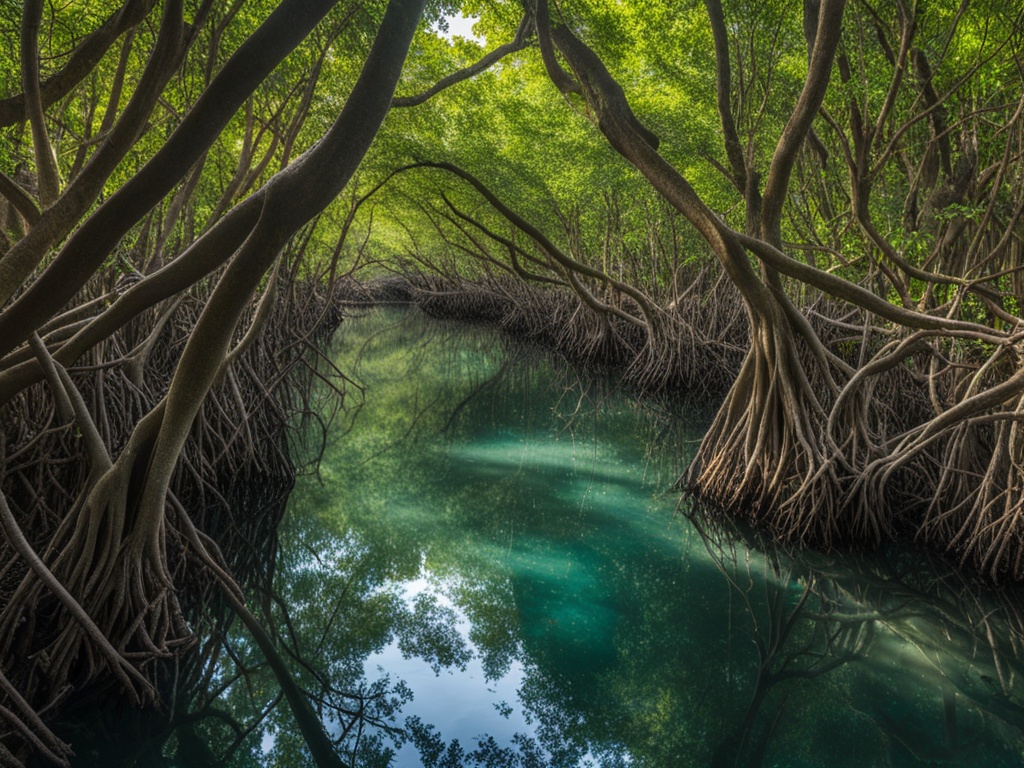Picture a place where giant mangrove trees grow in the water. Their roots form a complex web that gives shelter to a lively mix of creatures. Welcome to the Sundarbans National Park, located at the border of India and Bangladesh. It’s a UNESCO World Heritage site known for its rich variety of life, including the impressive Bengal tiger and many bird species. This makes it a favorite spot for those who love nature and wildlife.
The Sundarbans National Park is vast, filled with waterways and thick forests of mangroves. It’s a home to famous Bengal tigers and many birds. This park is a living example of the stunning resilience and beauty of nature.
Key Takeaways
- The Sundarbans National Park is a vast mangrove forest ecosystem that spans the border between India and Bangladesh.
- The park is renowned for its exceptional biodiversity, including the presence of the iconic Bengal tiger and numerous bird species.
- The Sundarbans has been recognized as a UNESCO World Heritage site due to its outstanding universal value and unique ecological significance.
- The park’s intricate waterways and dense mangrove forests provide a rich and diverse habitat for a wide range of flora and fauna.
- Exploring the Sundarbans offers a unique and captivating experience for nature enthusiasts and wildlife lovers.
Introduction to the Sundarbans
The Sundarbans is an amazing mangrove forest area. It stretches across southern Bangladesh and the Indian state of West Bengal. Covering over 10,000 square kilometers, it’s the world’s biggest contiguous mangrove forest.
Geographical Location and Expanse
This area is vast, with islands, rivers, and waterways. It sits at the meeting point of the Ganges, Brahmaputra, and Meghna rivers. Tides constantly shape its unique environment.
Ecological Significance and Biodiversity
The Sundarbans’ size isn’t its only impressive feature. It’s a vital habitat for many plants and animals. The Bengal tiger, various birds, reptiles, and fish live here. This makes it a crucial area for biodiversity.
Exploring the Sundarbans National Park
At the Sundarbans National Park, visitors can take guided boat tours. They can travel through the complex network of mangrove-lined waterways. These tours let people see a variety of aquatic life and the thick mangrove forests.
Navigating the Mangrove Waterways
Exploring the mangrove waterways is enchanting and calm. In the park’s tidal channels and rivers, you see the amazing adaptations of the mangrove ecosystem. Mangrove forests, with their high roots and lush canopies, make an exciting backdrop for your exploration.
Spotting the Elusive Bengal Tiger
Finding the elusive Bengal tiger is a key draw at the Sundarbans National Park. This tiger is very good at hiding. But, with guides’ help and some luck, seeing this amazing creature can be life-changing.

Sundarbans National Park: A World Heritage Site
The Sundarbans National Park is a massive area of mangrove forests in India and Bangladesh. It’s a UNESCO World Heritage site. This title shows its big value and unique role in nature’s design. It’s a key spot to keep safe for the future.
These forests are home to many plants and animals. They are best known for the Bengal tiger. This place shows how people and nature can live together well. It’s about saving these areas for their plants, animals, and what they do for the Earth.
Being a World Heritage site, the Sundarbans National Park plays a big part in world nature protection. It works hard to keep this special forest safe. This way, everyone can see and learn from its amazing beauty and life.
The Unique Flora and Fauna
The Sundarbans is a haven for many types of flora and fauna, with the main star being the mangrove forest ecosystem. The trees in the Sundarbans have unique adaptations for the salty, tidal climate. They grow roots into the air and their leaves can get rid of salt.
Mangrove Species and Their Adaptations
The Sundarbans has vast mangrove forests that deal with the rough estuarine conditions well. The mangrove species there have adapted in amazing ways. They have roots above ground for stability, roots for breathing, and leaves that control salt levels.
Avian Diversity and Migratory Birds
The Sundarbans is famous for its rich bird life, with resident and migratory species flocking there. It’s not just birds, but also the Bengal tiger and many kinds of waterfowl, birds of prey, and songbirds. This makes the Sundarbans a vibrant home for many birds.
Aquatic Life and Estuarine Ecosystems
The estuarine ecosystems in the Sundarbans are a hotspot for a wide range of aquatic life. This includes fish, crustaceans, and more. The network of mangrove-lined waterways offers a special place for all these marine critters to live and thrive.

Threats and Conservation Efforts
The Sundarbans National Park, a site marked by UNESCO as a World Heritage site, faces many challenges. These affect the park’s ecosystem balance. Climate change has raised sea levels and coastal erosion. This danger is putting the park’s mangrove forests at risk. Additionally, actions like deforestation, poaching, and over-exploitation threaten the unique plants and animals.
Environmental Challenges and Climate Change
The Sundarbans faces severe impacts from climate change. Rising sea levels and harsh weather patterns are big threats. Mangrove ecosystems are already feeling the effects. This situation changes animal and plant habitats, especially for the Bengal tiger.
Until now, efforts to protect this area have been crucial. Steps to lessen climate change’s effects are key. This aims to safeguard the Sundarbans’ delicate balance.
Local Community Involvement and Sustainable Tourism
Keeping the Sundarbans safe for the future needs the help of nearby communities. Efforts focus on promoting practices of tourism and managing natural resources wisely. This involves local people in making sure tourism is eco-friendly.
Such planning is vital. It helps protect the park while letting others enjoy its wonders. The idea is to keep nature and the local economy in harmony.
Cultural Significance and Indigenous Communities
The Sundarbans is very important to the locals who have lived there for many years. They created a strong bond with the mangrove forests. This bond guides their way of life and use of the area’s resources.
Traditional Livelihoods and Sustainable Practices
The folks from the Sundarbans really understand the forest’s balance. They rely on fishing, gathering honey, and using plants for medicine. These activities have been taught from one generation to the next.
Their life centers around the Sundarbans, shaping their cultural practices. They know the forest well, allowing them to live with nature peacefully. Their lifestyle is a great example of living in harmony with the Earth.

The Sundarbans now faces big challenges. The locals’ help and knowledge are key to protecting it. Their ways offer a model for effective environment management. They help the Sundarbans flourish as a diverse mangrove forest.
Exploring the Sundarbans: Practical Tips
If you’re keen on the Sundarbans National Park, here are some handy tips. The best time to visit is mostly between November and March. This is when the weather is cooler and you’re more likely to see wildlife.
Best Time to Visit and Tour Operators
In the dry season, the park is perfect for exploring by boat. You can see a lot of different plants and animals. Good tour operators arrange boat trips and safaris. This way, you can fully enjoy the park’s beauty.
Safety Precautions and Responsible Tourism
It’s critical to be safe and eco-friendly when in the Sundarbans. Always listen to the advice of your guides and local authorities. Also, make sure you’re not disturbing the wildlife or their home.
Future of the Sundarbans National Park
The Sundarbans National Park’s future depends on smart conservation plans. It also relies on finding a balance between nature’s preservation and people’s needs. This includes using methods like bringing back natural habitats, watching over wildlife, and supporting eco-tourism.
Long-term Conservation Strategies
Many groups are hard at work to keep the Sundarbans a healthy mangrove forest. They are working with governments, locals, and worldwide partners. This aims to fight climate change and keep the park safe from human harm.
Balancing Preservation and Development
Keeping the Sundarbans’ beauty and helping local areas grow is key for its future. This needs new ideas that put the forests and animals first, but also help people. Working together can lead to a way that protects both nature and communities.




